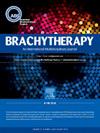凝胶间隔辅助挽救近距离治疗宫颈癌晚期放化疗后盆腔复发:一项单机构回顾性研究。
IF 1.8
4区 医学
Q4 ONCOLOGY
引用次数: 0
摘要
目的:评价凝胶间隔辅助高剂量率(HDR)补救性近距离放射治疗宫颈癌晚期放化疗(CRT)后盆腔复发的安全性和有效性。方法和材料:我们回顾性分析了2016年至2024年间连续15例宫颈癌确诊CRT后盆腔复发接受补救性HDR间质近距离放疗的患者。在每次近距离治疗期间,在经直肠超声引导下,在复发肿瘤和邻近危险器官(主要是直肠和膀胱)之间注射凝胶间隔剂。通过比较凝胶隔离剂体积的假设剂量(假设没有使用隔离剂)与桨的实际剂量来评估隔离剂的有效性。结果:再照射期间2 Gy组分(EQD2, α/β = 10)的中位生物等效剂量为64.0 Gy(范围:44.5-72.0 Gy)。中位随访22个月(范围:0 ~ 93个月),完全缓解率为66.7%(10/15)。与不使用间隔剂的假设剂量估计相比,凝胶间隔剂注射显著降低直肠D2cc中位数29%(四分位数间距[IQR]: 14%-55%),膀胱D2cc显著降低16% (IQR: 10%-34%) (Wilcoxon sign -rank检验,p )。凝胶间隔辅助的补救性近距离放疗显著减少了关键桨叶的辐射暴露,特别是直肠,同时对宫颈癌盆腔复发患者在最终CRT后实现了有效的肿瘤控制。这些有希望的结果支持这种方法是可行和安全的策略,需要在更大的前瞻性研究中进一步验证。本文章由计算机程序翻译,如有差异,请以英文原文为准。
Gel spacer-assisted salvage brachytherapy for pelvic recurrence after definitive chemoradiotherapy in cervical cancer: A single-institution retrospective study
PURPOSE
To evaluate the safety and efficacy of gel spacer-assisted high-dose-rate (HDR) salvage brachytherapy for pelvic recurrence after definitive chemoradiotherapy (CRT) for cervical cancer.
METHODS AND MATERIALS
We retrospectively analyzed 15 consecutive patients who underwent salvage HDR interstitial brachytherapy for pelvic recurrence following definitive CRT for cervical cancer between 2016 and 2024. Gel spacers were injected between the recurrent tumors and adjacent organs at risk (OARs), mainly the rectum and bladder, under transrectal ultrasound guidance at each brachytherapy session. The spacer’s effectiveness was evaluated by comparing the hypothetical dose delivered to the gel spacer volume (assuming no spacer was used) with the actual dose to the OARs.
RESULTS
The median biological equivalent dose in 2-Gy fractions (EQD2, α/β = 10) delivered during reirradiation was 64.0 Gy (range: 44.5–72.0 Gy). After a median follow-up of 22 months (range: 0–93 months), the complete response rate was 66.7% (10/15). Gel spacer injection significantly reduced the rectal D2cc by a median of 29% (interquartile range [IQR]: 14%–55%) and the bladder D2cc by 16% (IQR: 10%–34%) compared with the hypothetical dose estimates assuming no spacer use (Wilcoxon signed-rank test, p < 0.001). Grade ≥3 late toxicities occurred in only one patient (10.0%) among complete responders, and no spacer-related adverse events were observed.
CONCLUSIONS
Gel spacer-assisted salvage brachytherapy significantly reduced radiation exposure to critical OARs, particularly the rectum, while achieving effective tumor control in patients with pelvic recurrence of cervical cancer after definitive CRT. These promising results support this approach as a feasible and safe strategy, warranting further validation in larger prospective studies.
求助全文
通过发布文献求助,成功后即可免费获取论文全文。
去求助
来源期刊

Brachytherapy
医学-核医学
CiteScore
3.40
自引率
21.10%
发文量
119
审稿时长
9.1 weeks
期刊介绍:
Brachytherapy is an international and multidisciplinary journal that publishes original peer-reviewed articles and selected reviews on the techniques and clinical applications of interstitial and intracavitary radiation in the management of cancers. Laboratory and experimental research relevant to clinical practice is also included. Related disciplines include medical physics, medical oncology, and radiation oncology and radiology. Brachytherapy publishes technical advances, original articles, reviews, and point/counterpoint on controversial issues. Original articles that address any aspect of brachytherapy are invited. Letters to the Editor-in-Chief are encouraged.
 求助内容:
求助内容: 应助结果提醒方式:
应助结果提醒方式:


